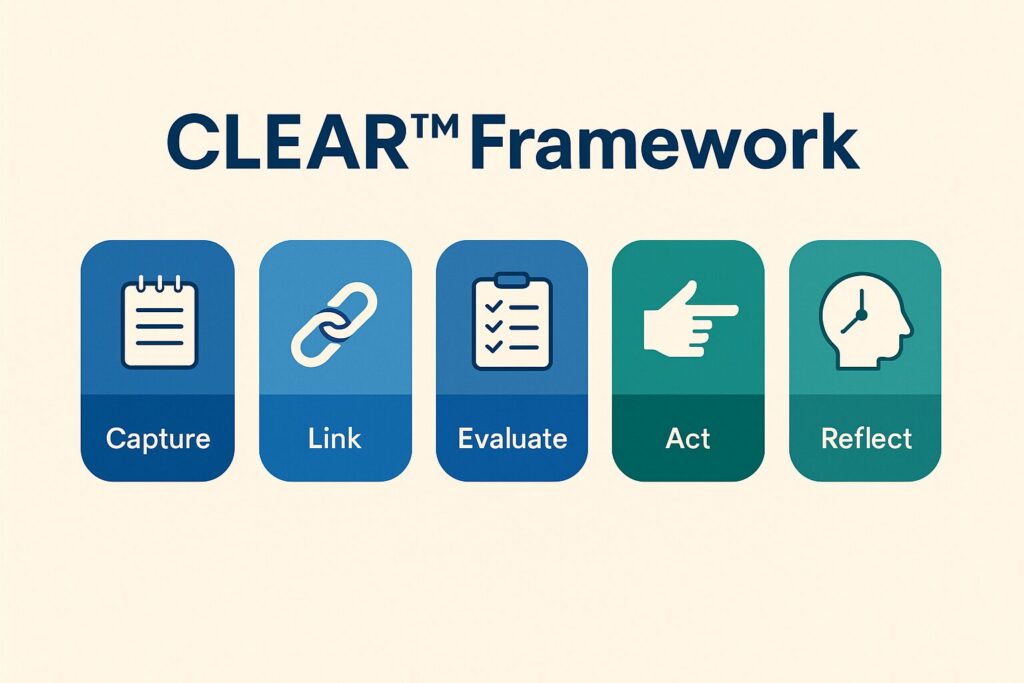Picture this: You’re drowning in Slack notifications, back-to-back meetings, and a to-do list that grows longer every time you cross something off. Sound familiar?
Six months ago, I was that leader. The one who looked busy but felt like I was running in circles. My team was frustrated, and my boss asked tough questions. Whether I was cut out for this whole leadership thing was starting to be questioned.
Then, I discovered something that changed everything: I needed to build my personal operating system. It was like a beacon of hope in the chaos, a roadmap to empowerment.
Not the Windows or Mac kind – I’m talking about a systematic approach to processing information, making decisions, and leading my team. It’s the difference between reactive and strategic, managing chaos and creating clarity.
If you’re a new manager feeling overwhelmed or an experienced leader tired of feeling like you’re always playing catch-up, this framework will transform how you approach leadership. Let me show you exactly how I built mine – and how you can make yours, too.

What Most New Leaders Get Completely Wrong
Here’s the thing nobody tells you about stepping into leadership: You can’t just wing it and hope for the best.
I learned this the hard way during my first month as a team lead at a fast-growing startup. Being a good leader meant being available to everyone all the time. My calendar looked like Swiss cheese – fifteen-minute gaps between meetings, lunch “breaks” spent answering emails, and late nights trying to catch up on actual work.
The wake-up call came during a fierce week. I missed a critical client deadline because I forgot to follow up on a deliverable. My star performer was considering leaving because she felt unsupported. And I realized I hadn’t had a single strategic thought in weeks – I was reacting to whatever fire seemed loudest.
The rookie mistake? I was trying to be everything to everyone without any system to guide my decisions.
Most new managers make this same error. They think leadership is about being the busiest person in the room, who has their finger in every pie. But here’s what I discovered: The best leaders aren’t the busiest – they’re the most intentional. They’re aware of their actions and their impact.
That’s when I started building what I now call my operating system – a framework that helps me process information, prioritize ruthlessly, and lead with clarity instead of chaos.
The CLEAR Framework: My Personal Operating System

After months of trial and error (and more than a few embarrassing mistakes), I developed a system that works. I call it the CLEAR framework:
- Capture everything
- Link to strategic priorities
- Evaluate impact and urgency
- Act with intention
- Reflect and refine
Let me walk you through each component and how it transforms daily leadership chaos into strategic clarity.
Capture Everything: Your External Brain
The first pillar of any solid personal operating system is getting everything out of your head. I use a simple three-bucket system:
Inbox (Daily dump): I spend 10 minutes brain-dumping everything swirling in my head every morning. Meeting notes, random ideas, and things I need to follow up on all go here first.
Projects (Weekly review): These are the bigger initiatives that require multiple steps. I keep a running list with clear owners and deadlines.
Someday/Maybe (Monthly purge): This is where good ideas go to live until they’re ready for prime time. It keeps my active lists clean while preserving potentially valuable thoughts.
The magic happens when you trust your system enough to let your brain focus on thinking, not remembering.
Link to Strategic Priorities: The North Star Filter
Here’s where most productivity systems fail leaders: they focus on efficiency without effectiveness. You can organize your tasks perfectly and still work on the wrong things.
Every quarter, I identify three strategic priorities that will make the most significant difference for my team and organization. Every task, meeting, and decision gets filtered through this lens:
Does this move us closer to our strategic priorities?
If yes, it gets prioritized. If not, it gets delegated, delayed, or deleted. This simple filter has helped me say no to dozens of “urgent” requests that would have derailed important work.
Evaluate Impact and Urgency: Beyond the Eisenhower Matrix
The traditional urgent/essential matrix is a good start, but I’ve evolved it for modern leadership challenges. I use what I call the Impact-Influence Assessment:
- High Impact, High Influence: Do immediately. High Impact, Low Influence: Collaborate or escalate
- Low Impact, High Influence: Delegate or automate Low Impact, Low Influence: Eliminate ruthlessly
Focusing on high-impact work allows me to create value while building the right systems and relationships for long-term success.
Act with Intention: The Power of Themed Days
Random fact: Research from Stanford shows that task-switching can reduce productivity by up to 40%. Yet most leaders ping-pong between completely different types of work all day long.
I solved this by creating themed focus blocks:
Monday Mornings: Strategic planning and team alignment. Tuesday/Wednesday: Deep work and project execution
Thursday: One-on-ones and relationship building. Friday: Reflection, cleanup, and next week’s prep
I am not inflexible. Emergencies happen. However, having themes helps me to batch similar work and stay focused on the projects that matter most.
Reflect and Refine: The Weekly Leadership Audit
Every Friday, I spend 30 minutes reviewing my week through four lenses:
- Energy: What gave me energy vs. what drained it?
- Impact: What created real value vs. what was just busy work?
- Relationships: How did I show up for my team and stakeholders?
- Systems: What processes worked well vs. what needs improvement?
This reflection helps me refine my operating system and catch problems before they become crises.
Real-World Application: The Product Launch That Changed Everything
Let me share how this framework played out during one of our biggest product launches last quarter.
I would have approached this launch reactively – taking every meeting, responding to every Slack message immediately, and trying to personally stay on top of every detail. The result would have been a stressed team, missed deadlines, and a leader who looked busy but added little strategic value.
Instead, I applied the CLEAR framework:
Captured all launch requirements and stakeholder concerns in one place. Linked every task to our three strategic priorities (user experience, timeline, and team development)
Evaluated were the decisions that required my direct input versus those that could be delegated.
Acted with themed focus blocks – mornings for strategic decisions, afternoons for team support
Reflected weekly on what was working and what needed adjustment
The result? We launched two weeks early, our team felt supported throughout the process, and I could think strategically about our next quarter.
More importantly, my team started adopting similar systems. According to McKinsey research, organizations with strong operational systems are 2.2x more likely to be top-quartile performers. When leaders model systematic thinking, it cascades throughout the organization.
Quick Wins You Can Implement This Week
Ready to start building your operating system? Here are five changes you can make immediately:
- Start your morning brain dump: Spend 10 minutes each morning getting everything out of your head onto paper (or digital notes). Focusing your priorities this way will improve your mental clarity.
- Identify your three strategic priorities: What are the three most important outcomes you need to achieve this quarter? Write them down and put them somewhere visible.
- Audit your meeting calendar: For each recurring meeting, ask, “Does this directly support one of my strategic priorities?” If not, consider delegating or eliminating.
- Create one themed focus block: Pick your highest-energy time of day and protect it for deep work on strategic priorities. Start with just 2 hours, twice a week.
- Schedule weekly reflection time: Block 30 minutes every Friday to review your week. What worked? What didn’t? What will you adjust next week?
The Compound Effect of Systematic Leadership
Here’s what most leadership advice gets wrong: it focuses on individual tactics instead of systematic thinking. However, the real power comes from building personal operating systems that compound over time.
Six months after implementing this framework, I’m not just more productive – I’m more strategic. My team trusts me more because I’m consistent and reliable. My boss sees me as someone who can handle bigger challenges because I’ve proven I can create clarity from chaos.
Most importantly, I enjoy leadership again. Instead of feeling constantly overwhelmed, it is intentional and effective.
Every successful leader has some version of a personal operating system – they might not call it that. Whether you build yours intentionally or let it evolve haphazardly through trial and error is the difference.
Your team deserves a leader who operates with clarity and intention. Your organization needs someone who can create systems that scale. And honestly? You deserve to feel confident and effective in your role.
The chaos will always be there. But with the right operating system, you can transform it into clarity and become the leader your team needs.
Related Articles
AI Agents Are Here: Unlock Growth, Speed & Scale in 2025
Unlock Better MarTech with AI Marketing Automation
Win With AI: A Proven 5-Step Guide for Founders
About the Author
I write about:
- AI + MarTech Automation
- AI Strategy
- COO Ops & Systems
- Growth Strategy (B2B & B2C)
- Infographic
- Leadership & Team Building
- My Case Studies
- Personal Journey
- Revenue Operations (RevOps)
- Sales Strategy
- SEO & Digital Marketing
- Strategic Thinking
📩 Want 1:1 strategic support?
🔗 Connect with me on LinkedIn
📬 Read my playbooks on Substack

Leave a Reply